| |
| | |
|
|
Pervasive Games
How to create social computer games in the environment?
|
| | |
 Ubiquitous Computing Ubiquitous Computing
 Ubiquitous Media Ubiquitous Media
 Hybrid Libraries Hybrid Libraries
 Museum Technology Museum Technology
Pervasive Games
 Color Quantization Color Quantization
 Image Compression Image Compression
 Quality of Service Quality of Service
 Intelligent Internet Services Intelligent Internet Services
 Seamless Media Adaptation Seamless Media Adaptation
 Supervised Theses Supervised Theses

|
With pervasive gaming, novel types of games have recently emerged. The general idea is to apply pervasive computing technology
- which embeds computing and interfacing capabilities in real-world, everyday objects - to games. By bringing gaming back to
natural, social interaction spaces, pervasive gaming aims to overcome certain restrictions of conventional computer games:
Players are no longer tied to computer screens and human-computer interaction is not constrained by graphical user interfaces
(GUIs) of desktop PCs. In this way, pervasive gaming allows for creating novel game experiences that integrate modern computing
technology with crucial aspects of traditional non-computer games.
A specific enhancement of pervasive game design is given by the usage of tangible user interfaces (TUIs, Hiroshi Ishii, MIT).
TUIs support the use of graspable – not just pervasive – real-world objects as intuitive interfaces that follow familiar
metaphors and allow for conveniently combining real and virtual worlds.
Within the Game Design course given at the ISNM in 2004, 2005 and 2006, several pervasive games have been developed.
|
| | |


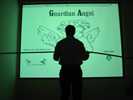

|
 Guardian Angel Guardian Angel
How to balance on a virtual rope?
The game concept of Guardian Angel was developed within the Game Design course of the ISNM in 2004 and
is based on the idea of guiding a virtual figure across a tight rope.
The walker is attempting a new world record by trying to make it across the biggest valley in the world.
The player acts as the tightrope walkers Guardian Angel and helps him keeping his balance as
he makes his way across the rope. The image of the valley and the walker conceived as a Flash movie
is projected onto a wall so the game player is immersed in a virtual environment.
The balancing pole becomes the tangible interface. It works by a rotation sensor at its centre that
responds to the "balancing" motion of the player as he/she moves in front the image on the wall.
The project was realized using hardware rotation sensors with USB interface. Flash events are generated
and used to trigger respective animations.
|
| | |

|
Details about Guardian Angel can be found in:
Bernhard Jung, Andreas Schrader and Darren V. Carlson
Tangible Interfaces for Pervasive Gaming
 DIGRA'2005: 2nd International Conference of the Digital Games Research Association.
Changing Views: Worlds in Play
Vancouver, British Columbia, Canada, June 16-20, 2005
DIGRA'2005: 2nd International Conference of the Digital Games Research Association.
Changing Views: Worlds in Play
Vancouver, British Columbia, Canada, June 16-20, 2005
Download paper at  DIGRA'2005
DIGRA'2005
|
| | |



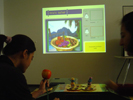
|
 Fruit Salad Fruit Salad
How to create a nice tasty fruit salad?
The game concept of Fruit Salad was developed within the Game Design course of the ISNM in 2004 and
is based on the metaphor of tangible user interfaces (TUIs) as proposed by Hiroshi Ishii from MIT
Media Lab.
Fruit Salad is a board game with fruits represented by RFID lables. The goal of the game is
to collect good combinations of individual fruit objects into physical salad bowls integrated
into the board. Each of the two salad bowls is connected to an RFID reader, thus making the
game logic aware of the current progress of fruit salad preparation. Moreover, a physical push button
is used to draw cards from a simulated card deck which indicates a player’s next turn (e.g.
move one forward, move two forward, pause, etc.). The board itself is composed of four round
discs each of which is connected to a motor. A hollow plastic apple hosts an accelerometer
(shaker) sensor which, when used during certain game state, triggers the rotation of the four
board discs, thus changing the spatial arrangement of the available fruits.
Through the integration of the physical game board, tangible interaction devices, computer
controlled game logic, and computer visualizations, the Fruit Salad game combines advantages
of computer games, such as animated multimedia presentations, and traditional, non-computer
games, such as its inherently social setting with direct face-to-face communication between the
players.
|
| | |

|
Details about Fruit Salad can be found in:
Bernhard Jung, Andreas Schrader and Darren V. Carlson
Tangible Interfaces for Pervasive Gaming
 DIGRA'2005: 2nd International Conference of the Digital Games Research Association.
Changing Views: Worlds in Play
Vancouver, British Columbia, Canada, June 16-20, 2005
DIGRA'2005: 2nd International Conference of the Digital Games Research Association.
Changing Views: Worlds in Play
Vancouver, British Columbia, Canada, June 16-20, 2005
Download paper at  DIGRA'2005
DIGRA'2005
|
| | |

|
See also:
Wendy Ann Mansilla, Sönke Dohrn and Alma Salim
Fruit Salad: A Mixture of Virtual and Tangible Interfaces for Social and Accessible Pervasive Gaming
 Mindplay,
A one day conference on digital media theory, culture, practice and play, London, UK, January 20, 2006. Mindplay,
A one day conference on digital media theory, culture, practice and play, London, UK, January 20, 2006.
|
| | |

|
See also:
The presentation of Wendy Ann at the Mindplay conference was mentioned in the January 2006 issue of the
 develop magazine develop magazine
|
| | |


|
 FruitSalad II FruitSalad II
How to assist impaired players?
Nowadays, more advanced multimedia and feedback tools and assistive technologies enable enhanced
gaming experiences. However, many publishers in the gaming market prefer to stay mainstream resulting
in a limited variety of gaming experiences available to physically impaired gamers. This is especially
the case for physically impaired gamers experiencing some social digression when playing computer
games or complex physical games.
Fruit Salad II is an improved version of the pervasive game Fruit Salad using tangible user interfaces
involving both physical and virtual experiences.
In real world, playing board games may be hard, tiring or perhaps impossible
for disabled people. The challenge of our work is to allow for supplementing physical activities
on such games using enhanced interface technologies.
The use of existing off-the-shelf development software (Flash, C#, MS Agent) and physical components
(Phidgets) allows a relatively simple and affordable design.
Fruit Salad II was tested with impaired people and demonstrated publicly on the ISNM Open House
and the Lübeck Informatik Jahrmarkt in the context
of the "Jahr der Informatik" of the German Computer Society (GI) in 2006.
|
| | |


|
Details about Fruit Salad II can be found in:
Wendy Ann Mansilla, Andreas Schrader, Soenke Dohrn and Alma Salim
Virtual and Tangible User Interfaces for Social and Accessible Pervasive Gaming
 Mensch & Computer 2006
Conference of the GI and the German Chapter of the ACM
Gelsenkirchen, Germany, September 3-6, 2006.
Proceedings: A. M. Heinecke, H. Paul (Ed.): Mensch & Computer 2006: Mensch und Computer im StrukturWandel.
Oldenbourg Verlag, Munich, Germany, 2006.
Mensch & Computer 2006
Conference of the GI and the German Chapter of the ACM
Gelsenkirchen, Germany, September 3-6, 2006.
Proceedings: A. M. Heinecke, H. Paul (Ed.): Mensch & Computer 2006: Mensch und Computer im StrukturWandel.
Oldenbourg Verlag, Munich, Germany, 2006.
|
| | |

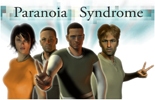
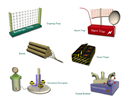


|
 Paranoia Syndrome Paranoia Syndrome
How to combine tangible and virtual game play?
Paranoia Syndrome is a pervasive, mobile multi-player game developed within the ISNM Game Design Course in 2005.
Paranoia Syndrome is a science-fiction strategy game about the battle between humans and an invisible alien race.
The playing field is a part of the real world and players move physically to reach certain locations and to achieve their goals.
In order to win, players have to act cooperatively as a team, with communication also taking place by real world means,
e.g., real voice, telephones or other telecommunication infrastructure. Interaction with the simulated game-world –
which can be thought of as being superimposed upon reality – is performed through two types of interfaces.
The Virtual Interface is realized as a graphical user interface on the PDA of each player.
It contains functions for querying information about the game situation and means for invoking actions.
The PDA interface thus acts as a kind of location-aware “magic lens” and is the only channel to perceive
the otherwise invisible aliens present in a specific location.
The Tangible Interface is realized by integrating specially prepared real-world objects.
These objects can be bought, used and sold (for game money) by all participants during game play.
Equipped with RFID labels, these Tangible Objects can be identified and operated by the user using the RFID scanner on the PDA.
|
| | |


|
Details about Paranoia Syndrome can be found in:
Guido Heumer, Darren V. Carlson, Sree Harsha Kaligiri, Supriya Maheshwari, Hasan-Waqar-Ul, Bernhard Jung and Andreas Schrader
Paranoia Syndrome – A Location Based Pervasive Multiplayer Game using PDAs, RFID, and Tangible Objects
Third International Workshop on Pervasive Gaming Applications - PerGames 2006,
Dublin, Ireland, May 7, 2006.
Download
 Conference Proceedings
Conference Proceedings
|
| | |


|
See also:
Guido Heumer, Darren Carlson, Bernhard Jung and Andreas Schrader
Paranoia Syndrome – A Pervasive Multiplayer Game.
In: Carsten Magerkurth, Carsten Röcker (eds.):
Pervasive Gaming Applications - A Reader for Pervasive Gaming Research, vol. 2.
 Shaker Verlag,
Herzogenrath, 2007.
Shaker Verlag,
Herzogenrath, 2007.
|
| | |

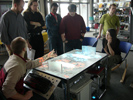

Trailer

Making Off

|
 Pictory Pictory
How to integrate Internet images in a table-top game?
Pictory has been developed within the Game Design course at the ISNM in 2006/2007.
It is a new pervasive table-top game using augmented video and sound for two teams.
It combines social interactivity with creative thinking. Pictory enhances the table-top paradigm
with online aspects by integrating online image database search during the game flow.
Teams have to protect their castles by specifying search keywords that are mapped to image collections retrieved from
online web services. In this way, Pictory combines online-gaming with physical pervasive game setup. Pictory is a
socially interactive, learning promoting, and thinking/imagination enhancing game that brings together human players,
objects, physical spaces, newly developed system architectures, and existing search engines. The game setup consists of
a graphical surface for the table projection, table equipment for the interaction and a computer below the table
containing the game software. As our main image search engine we use Google Search as today’s leading service.
Furthermore, the thumbnails are processed by being masked, resized, rotated, and localized properly to match the
graphical layout of the game and to optimize result retrieval speed.
|
| | |


|
Details about Pictory can be found in:
Bashar Al Takrouri, Luis Bustamante, Antonio Canonico, Michal Janiszewski, Evgenia Nikolova, Mantas Talmantas and Andreas Schrader
Pictory - A Hybrid Augmented Table-Top Game using Image Search Engines
4th International Symposium on Pervasive Gaming Applications - PerGames 2007,
Salzburg, Austria, June 11-12, 2007.
See
 Conference Proceedings
at Shaker.
Conference Proceedings
at Shaker.
|
| | |


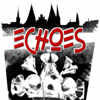
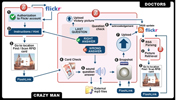
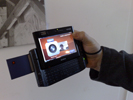
|
 ECHOES ECHOES
How to bring games to the city?
Computer games play an increasing role in our modern information society. Besides pure entertainment,
games can provide valuable input for social interaction, learning, etc. Recently, new pervasive game genres
have been developed, including mobile games, tangible games, table-top games, exhaustive games, mixed reality games, etc.
Pervasive games extend the traditional game experience by supporting natural contexts within game experiences.
ECHOES is a new mobile pervasive multi-player game which is played outside the boundaries of a building.
ECHOES combines the classic features of hunting games with the logic of riddles to create a fun and exhaustive experience in a city.
The story of ECHOES is based on a crazy man (the fugitive) who is locked up for treatment of his schizophrenia in a mental
institution. This patient is sure that there are sounds chasing him; telling him a special message that he must decipher.
The patient manages to escape from the hospital and embark in a quest to find the source of the sounds and prove to the world
that he is not crazy. He has to run across the streets of the city, searching, retrieving and recognizing sounds in a race that
will take him either to his freedom, or back to the mental institution.
ECHOES does not rely on standard location detection techniques (GSM signal strength or cell ID, RFID, etc.)
Rather, our game incorporates the location-guessing into the game-play and uses an existing online image platform (Flickr)
as the communication channel. In this way, social communication of Web 2.0 portals is extended to the real life scenario
using a game approach.
The system is based on two Sony Vaio UX180P Micro-PCs (UMPCs) which run the Windows Vista operating system and provide
built-in camera support. A compact flash RFID reader interface card was attached to each UMPC. Internet connection was
realized via cell phones connected as UMTS modems in order to be independent of WLAN coverage in the city.
The project was sponsored by the "Unabhängige Landesanstalt für Rundfunk und neue Medien (ULR) Schleswig-Holstein"
|
| | |


|
Details about ECHOES can be found in:
Karen Detken, Carlos Martinez, Darren Carlson, Varvara Guljajeva, Mari Klara Oja and Andreas Schrader
ECHOES – A Crazy Multiplayer Pervasive Game
Workshop for Mobile Gaming
( Mobile Gaming '08)
at (GI) Informatik'2008, Munich, Germany, September 9, 2008.
Mobile Gaming '08)
at (GI) Informatik'2008, Munich, Germany, September 9, 2008.
|
|
|
|